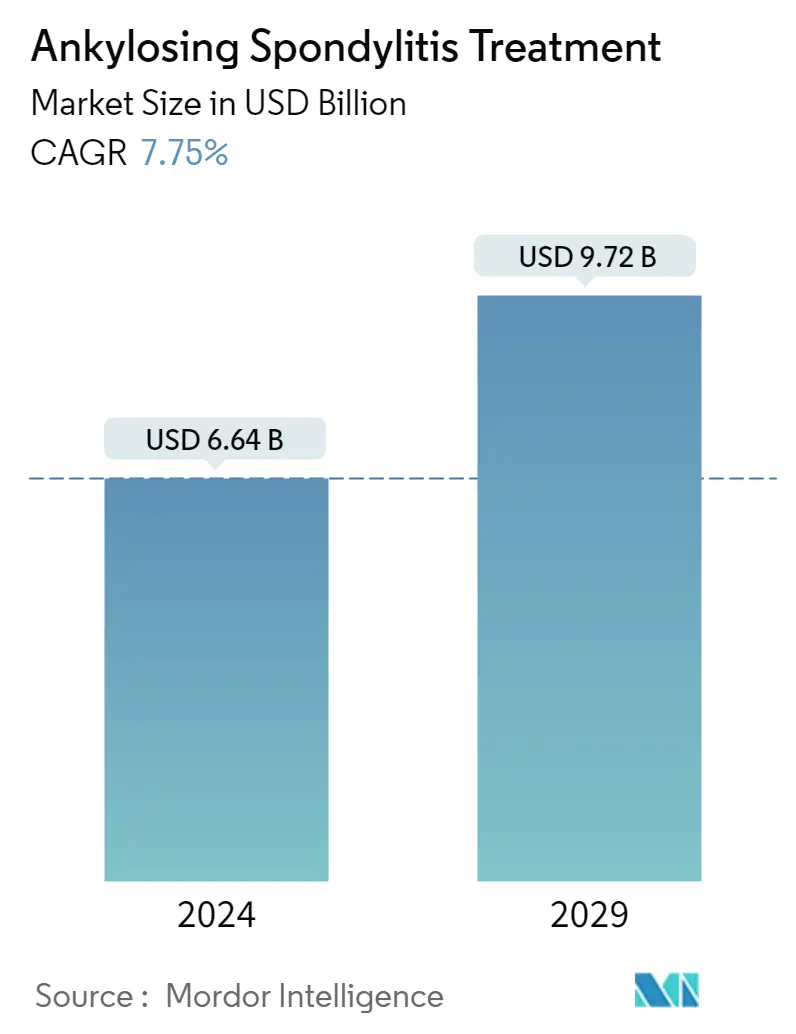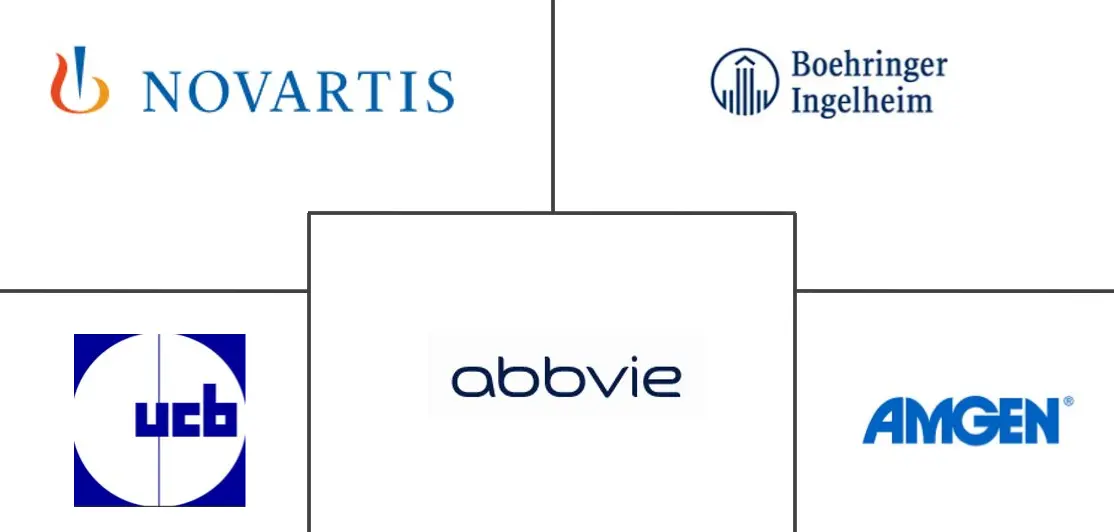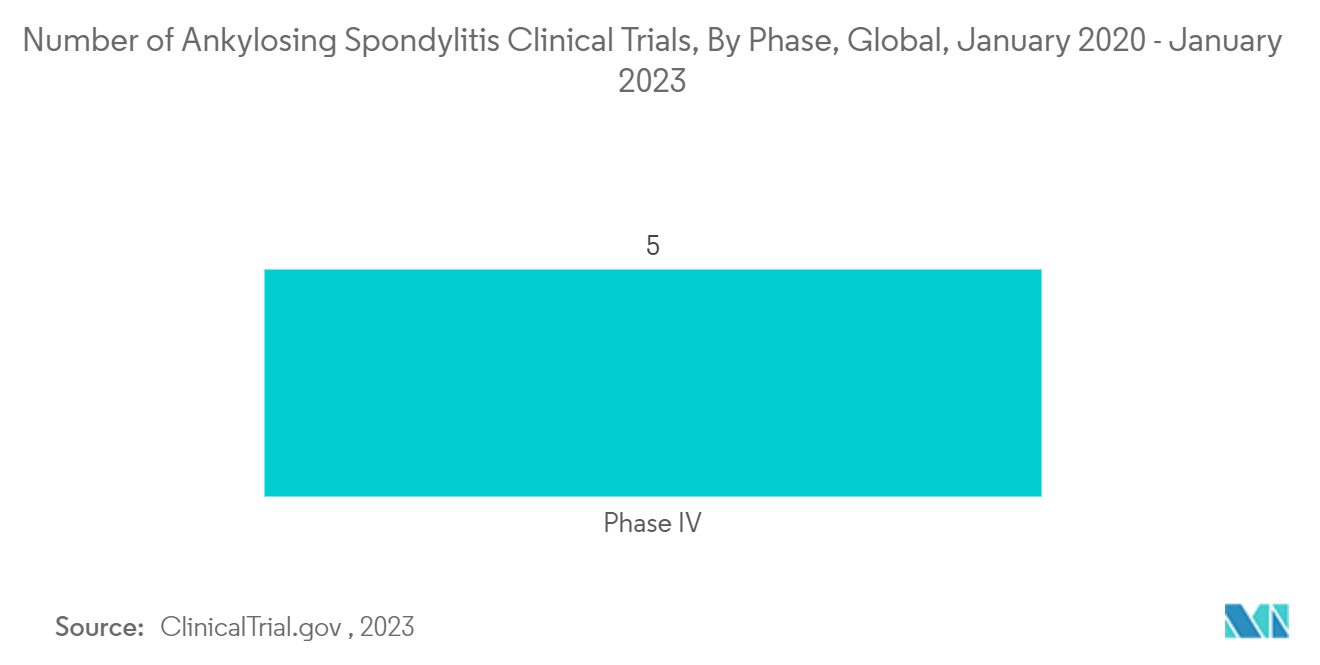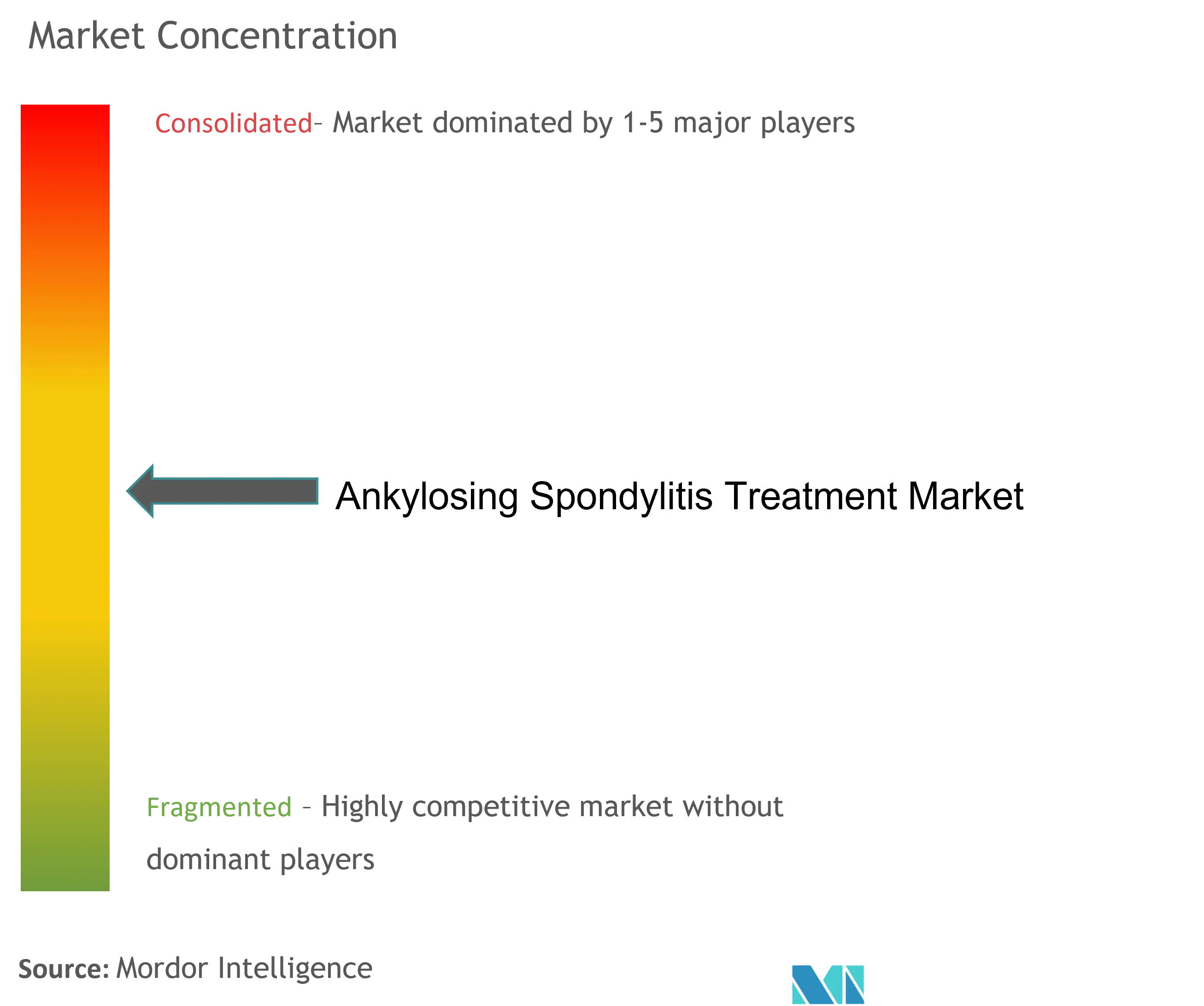Ankylosing Spondylitis Treatment Market Size

| Study Period | 2019 - 2029 |
| Market Size (2024) | USD 6.64 Billion |
| Market Size (2029) | USD 9.72 Billion |
| CAGR (2024 - 2029) | 7.75 % |
| Fastest Growing Market | Asia-Pacific |
| Largest Market | North America |
Major Players
*Disclaimer: Major Players sorted in no particular order |
Ankylosing Spondylitis Treatment Market Analysis
The Ankylosing Spondylitis Treatment Market size is estimated at USD 6.64 billion in 2024, and is expected to reach USD 9.72 billion by 2029, growing at a CAGR of 7.75% during the forecast period (2024-2029).
- Ankylosing spondylitis (AS), a chronic inflammatory disease primarily impacting the spine and large joints, requires a comprehensive treatment approach to manage symptoms and slow disease progression. The multifaceted treatment strategies for ankylosing spondylitis focus on alleviating pain, reducing inflammation, maintaining mobility, and preventing complications. Key treatment modalities include medications, physical therapy, and, in severe cases, surgery. Understanding the efficacy of various ankylosing spondylitis treatment options is critical for optimizing patient outcomes.
Diverse Treatment Options for Ankylosing Spondylitis
- Medications: The ankylosing spondylitis treatment landscape includes nonsteroidal anti-inflammatory drugs (NSAIDs), TNF inhibitors, IL-17 inhibitors, and other biologics. NSAIDs, such as ibuprofen and naproxen, are often the first-line treatment, providing relief from pain and inflammation. TNF inhibitors and IL-17 inhibitors are crucial for patients unresponsive to NSAIDs, offering targeted therapy to reduce inflammation and prevent further joint damage.
- Physical Therapy: Physical therapy is vital in maintaining spinal mobility and reducing pain, ensuring that patients retain function and quality of life. Regular exercise for ankylosing spondylitis, guided by physical therapists, helps in strengthening muscles, improving posture, and enhancing flexibility, which is essential for managing the disease.
- Surgical Interventions: Surgery for ankylosing spondylitis may be considered for patients with severe deformities or refractory symptoms that do not respond to conventional therapies. Surgical options include spinal fusion or hip replacement to address severe pain or deformity.
Escalating Disease Prevalence and Advancements in Reimbursement Models
- Increasing Prevalence: The global burden of ankylosing spondylitis is rising, particularly in regions with a high prevalence of autoimmune diseases. This trend has increased the demand for effective ankylosing spondylitis treatment options. As the understanding of the disease pathophysiology improves, more targeted therapies are developed, enhancing the overall management of ankylosing spondylitis.
- Reimbursement Models: Advancements in reimbursement models have significantly impacted patient access to ankylosing spondylitis medication, especially expensive biologics. In regions with robust healthcare systems, such as North America and Europe, reimbursement policies have evolved to facilitate patient access to high-cost treatments. Government subsidies and expanded insurance coverage have also played a critical role in increasing the adoption of advanced therapies like biologics for ankylosing spondylitis.
High Costs Pose Significant Challenges for Patients and Healthcare Systems
- Economic Barriers: Despite the therapeutic advancements, the high cost of biologic therapies remains a significant barrier to widespread adoption. Treatments like TNF inhibitors and IL-17 inhibitors are often priced at a premium, making them inaccessible to many patients, particularly in low- and middle-income countries. This financial burden can lead to decreased adherence to treatment regimens, resulting in suboptimal patient outcomes.
- Healthcare System Challenges: The high cost of ankylosing spondylitis treatment poses challenges for healthcare systems that must balance budget constraints with the need to provide comprehensive care. The cost-effectiveness of these treatments is under constant scrutiny, leading to varying levels of access based on the economic policies and healthcare infrastructure in place. This disparity highlights the need for developing more cost-effective treatment strategies that ensure equitable access to care.
Ankylosing Spondylitis Treatment Market Trends
Nonsteroidal Anti-Inflammatory Drugs (NSAIDs) Segment is Expected to Hold a Significant Market Share Over the Forecast Period
Rising Significance of Nonsteroidal Anti-Inflammatory Drugs (NSAIDs)
- First-Line Treatment: NSAIDs are increasingly recognized as essential in managing ankylosing spondylitis due to their efficacy in reducing pain and inflammation. As the first-line treatment, NSAIDs remain popular due to their affordability and widespread availability. Industry analysis indicates growing demand for NSAIDs, driven by the rising incidence of ankylosing spondylitis and the immediate relief these medications provide.
- Ongoing Innovation: The NSAIDs segment is expected to continue growing, fueled by ongoing research into new formulations with enhanced efficacy and fewer side effects. The introduction of potent NSAIDs with improved safety profiles is anticipated to increase their market value. Despite the increasing interest in biologics, NSAIDs are projected to maintain their significance in ankylosing spondylitis pain management strategies.
Market Expansion through Strategic Collaborations
- Product Launches and Approvals: Strategic initiatives such as product launches and approvals are driving the growth of the NSAIDs segment. For instance, the FDA’s approval of RINVOQ (upadacitinib) in 2022 as an oral treatment for ankylosing spondylitis highlights the ongoing innovation within this segment. These developments are expected to drive demand and solidify NSAIDs' role in the ankylosing spondylitis treatment market.

North America's Dominance in the Ankylosing Spondylitis Treatment Market
Market Leadership in North America
- Advanced Healthcare Infrastructure: North America, particularly the United States, is expected to maintain its dominant position in the ankylosing spondylitis treatment market due to its advanced healthcare infrastructure and high disease awareness. The availability of cutting-edge ankylosing spondylitis medication, including biologics and TNF inhibitors, supports the region’s market leadership.
- Innovative Treatments: The continuous development and approval of innovative treatments further fuel North America’s market growth. For example, Coherus Biosciences' FDA approval of Yusimry (adalimumab) in 2021 exemplifies the region’s commitment to advancing ankylosing spondylitis treatment options.
Supportive Reimbursement Policies and Patient Assistance
- Financial Assistance Programs: The growth of the ankylosing spondylitis treatment market in North America is bolstered by favorable reimbursement policies and patient assistance programs. Organizations like the Patient Access Network (PAN) Foundation provide financial assistance, reducing the economic burden of treatment and ensuring access to advanced therapies.

Ankylosing Spondylitis Treatment Industry Overview
Moderately Consolidated Market with Global Leaders
- Market Structure: The ankylosing spondylitis treatment market is moderately consolidated, with a few global pharmaceutical companies dominating the market through strong portfolios of biologics and biosimilars. These companies leverage their extensive R&D capabilities and robust distribution networks to maintain their market presence.
- Biologics and Biosimilars: Leading players like Novartis AG, AbbVie Inc., and Amgen Inc. have maintained their dominance through continuous innovation in biologic therapies, which are now standard treatment options for ankylosing spondylitis. These companies’ strong brand recognition and strategic alliances further enhance their market reach.
Key Trends and Future Success Factors
- Focus on Biosimilars: A significant trend in the ankylosing spondylitis treatment market is the increasing focus on biosimilars and next-generation biologics, which offer the potential to reduce treatment costs while maintaining efficacy. For market players, success will hinge on investing in biosimilar development, expanding into emerging markets, and maintaining a strong pipeline of innovative treatments.
Ankylosing Spondylitis Treatment Market Leaders
-
Novartis AG
-
AbbVie Inc.
-
Amgen Inc.
-
Boehringer Ingelheim International GmbH
-
UCB S.A.
*Disclaimer: Major Players sorted in no particular order

Ankylosing Spondylitis Treatment Market News
- In May 2024, Teva Pharmaceutical Industries Ltd. launched SIMLANDI (adalimumab-ryvk) injection in the United States as an interchangeable biosimilar to Humira for the treatment of adult ankylosing spondylitis and other conditions.
- In December 2023, UCB secured approval from the Japanese Ministry of Health, Labour and Welfare (MHLW) for BIMZELX (bimekizumab). This approval is specifically for treating adults with psoriatic arthritis (PsA), non-radiographic axSpA (nr-axSpA), and ankylosing spondylitis (AS) who haven't adequately responded to current therapies.
Ankylosing Spondylitis Treatment Market Report - Table of Contents
1. INTRODUCTION
- 1.1 Study Assumptions and Market Definition
- 1.2 Scope of the Study
2. RESEARCH METHODOLOGY
3. EXECUTIVE SUMMARY
4. MARKET DYNAMICS
- 4.1 Market Overview
-
4.2 Market Drivers
- 4.2.1 Growing Burden of Target Diseases and Rising Reimbursements for the Treatment
- 4.2.2 Research and Development for Effective Treatment
-
4.3 Market Restraints
- 4.3.1 High Cost of Treatment
-
4.4 Porter's Five Force Analysis
- 4.4.1 Threat of New Entrants
- 4.4.2 Bargaining Power of Buyers/Consumers
- 4.4.3 Bargaining Power of Suppliers
- 4.4.4 Threat of Substitute Products
- 4.4.5 Intensity of Competitive Rivalry
5. MARKET SEGMENTATION (Market Size by Value - USD)
-
5.1 By Treatment Types
- 5.1.1 Medication
- 5.1.1.1 Nonsteroidal Anti-Inflammatory Drugs (NSAIDs)
- 5.1.1.2 TNF Inhibitors
- 5.1.1.3 IL-17 Inhibitors
- 5.1.1.4 Others
- 5.1.2 Therapy
- 5.1.3 Surgery
-
5.2 Geography
- 5.2.1 North America
- 5.2.1.1 United States
- 5.2.1.2 Canada
- 5.2.1.3 Mexico
- 5.2.2 Europe
- 5.2.2.1 Germany
- 5.2.2.2 United Kingdom
- 5.2.2.3 France
- 5.2.2.4 Italy
- 5.2.2.5 Spain
- 5.2.2.6 Rest of Europe
- 5.2.3 Asia-Pacific
- 5.2.3.1 China
- 5.2.3.2 Japan
- 5.2.3.3 India
- 5.2.3.4 Australia
- 5.2.3.5 South Korea
- 5.2.3.6 Rest of Asia-Pacific
- 5.2.4 Middle East and Africa
- 5.2.4.1 GCC
- 5.2.4.2 South Africa
- 5.2.4.3 Rest of Middle East and Africa
- 5.2.5 South America
- 5.2.5.1 Brazil
- 5.2.5.2 Argentina
- 5.2.5.3 Rest of South America
6. COMPETITIVE LANDSCAPE
-
6.1 Company Profiles
- 6.1.1 Novartis AG (Sandoz)
- 6.1.2 AbbVie Inc.
- 6.1.3 UCB
- 6.1.4 Amgen Inc.
- 6.1.5 Boehringer Ingelheim International GmbH
- 6.1.6 Celltrion Healthcare
- 6.1.7 Reliance Life Sciences
- 6.1.8 Johnson & Johnson Services, Inc.
- 6.1.9 Eli Lilly and Company
- 6.1.10 Gilead Sciences, Inc.
- 6.1.11 Merck & Co., Inc.
- 6.1.12 Pfizer Inc
- *List Not Exhaustive
7. MARKET OPPORTUNITIES AND FUTURE TRENDS
** Subject To AvailablityAnkylosing Spondylitis Treatment Industry Segmentation
As per the scope of the report, ankylosing spondylitis (previously known as Bechterew's disease, Bechterew syndrome, Marie Strümpell disease) is a chronic inflammatory immune-mediated condition primarily affecting the sacroiliac joints and spine.
The ankylosing spondylitis treatment market is segmented by treatment types and geography. By treatment type, the market is segmented into medication, therapy, and surgery. The medication segment includes nonsteroidal anti-inflammatory drugs (NSAIDs), TNF inhibitors, IL-17 inhibitors, and others. By geography, the market is segmented into North America, Europe, Asia-Pacific, the Middle East and Africa, and South America. The market report also covers the estimated market sizes and trends for 17 different countries across major regions globally. The report offers the value (in USD) for the above segments.
| By Treatment Types | Medication | Nonsteroidal Anti-Inflammatory Drugs (NSAIDs) |
| TNF Inhibitors | ||
| IL-17 Inhibitors | ||
| Others | ||
| By Treatment Types | Therapy | |
| Surgery | ||
| Geography | North America | United States |
| Canada | ||
| Mexico | ||
| Geography | Europe | Germany |
| United Kingdom | ||
| France | ||
| Italy | ||
| Spain | ||
| Rest of Europe | ||
| Geography | Asia-Pacific | China |
| Japan | ||
| India | ||
| Australia | ||
| South Korea | ||
| Rest of Asia-Pacific | ||
| Geography | Middle East and Africa | GCC |
| South Africa | ||
| Rest of Middle East and Africa | ||
| Geography | South America | Brazil |
| Argentina | ||
| Rest of South America |
Ankylosing Spondylitis Treatment Market Research FAQs
How big is the Ankylosing Spondylitis Treatment Market?
The Ankylosing Spondylitis Treatment Market size is expected to reach USD 6.64 billion in 2024 and grow at a CAGR of 7.75% to reach USD 9.72 billion by 2029.
What is the current Ankylosing Spondylitis Treatment Market size?
In 2024, the Ankylosing Spondylitis Treatment Market size is expected to reach USD 6.64 billion.
Who are the key players in Ankylosing Spondylitis Treatment Market?
Novartis AG, AbbVie Inc., Amgen Inc., Boehringer Ingelheim International GmbH and UCB S.A. are the major companies operating in the Ankylosing Spondylitis Treatment Market.
Which is the fastest growing region in Ankylosing Spondylitis Treatment Market?
Asia-Pacific is estimated to grow at the highest CAGR over the forecast period (2024-2029).
Which region has the biggest share in Ankylosing Spondylitis Treatment Market?
In 2024, the North America accounts for the largest market share in Ankylosing Spondylitis Treatment Market.
What years does this Ankylosing Spondylitis Treatment Market cover, and what was the market size in 2023?
In 2023, the Ankylosing Spondylitis Treatment Market size was estimated at USD 6.13 billion. The report covers the Ankylosing Spondylitis Treatment Market historical market size for years: 2019, 2020, 2021, 2022 and 2023. The report also forecasts the Ankylosing Spondylitis Treatment Market size for years: 2024, 2025, 2026, 2027, 2028 and 2029.
Global Ankylosing Spondylitis Treatment Industry Report
Our in-depth industry research on the ankylosing spondylitis treatment market offers comprehensive insights into the multifaceted approaches and evolving trends that are shaping patient care. The report delves into various ankylosing spondylitis treatment options, including biologics, NSAIDs, and physical therapy, providing stakeholders with critical information on the efficacy and accessibility of these therapies. Our analysis covers market segmentation, geographic trends, and the competitive landscape, highlighting key market leaders and their strategic initiatives. This industry research is an indispensable resource for healthcare providers, pharmaceutical companies, and policymakers, providing actionable intelligence to optimize patient outcomes and drive market growth.
All the insights are available in an easy-to-read report pdf format, ensuring that stakeholders can access detailed market data, industry statistics, and forecasts with ease. The report offers an in-depth review of market trends, including the rising demand for ankylosing spondylitis biologic treatment and the growing significance of NSAIDs for pain management. Additionally, the report provides a comprehensive industry outlook, with market predictions and an analysis of emerging opportunities. With this robust industry information, stakeholders are equipped to navigate the complexities of the ankylosing spondylitis treatment market and capitalize on growth opportunities.
Statistics for the 2024 Ankylosing Spondylitis Treatment market share, size and revenue growth rate, created by Mordor Intelligence™ Industry Reports. Ankylosing Spondylitis Treatment analysis includes a market forecast outlook to for 2024 to 2029 and historical overview. Get a sample of this industry analysis as a free report PDF download.



